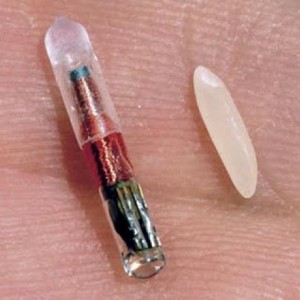Implication of ‘Human Chipping’ on personal identity – Part 1: Are we Cyborgs?
The first RFID implant on a human being was performed in August of 1998 on the upper left arm of Professor Kevin Warwick in Reading, England (Gasson, ICT Implants, 2008). The implant was cylindrical in structure having a length of 22mm and diameter of 4mm. The doctor required to make a small hole, place the RFID chip and close the incision with couple of stitches. The implant allowed Professor Warwick to control lights, open doors and even receive welcome messages when he arrived. His location in the building could be tracked and monitored. This was only experimental and hence other possible applications of the technology were not considered by the scientists at that time.
One of the first commercial application of RFID chips was to replace ‘medic alert’ bracelets by VeriChip Corporation in 2004 (Gasson, ICT Implants, 2008). It was approved by the FDA in the United States of America for human use. It was used to relay medical details when linked to online medical database. For example, the details of the patient’s diabetes can be stored in the chips and because it is implanted, the patient cannot forget it or lose it. Later on the company also used these chips for infant protection and patient monitoring in hospitals. Subsequently these chips were used by nightclubs in Barcelona and Rotterdam to allow access to their VIP members. For example, at the Baja Beach Club in Rotterdam, these chips were implanted in their VIP members and were used for not only entry into the club but also for ordering drinks. For instance, if a member bought a drink, the chip could be read by an RFID reader and the amount can be deducted from the bank directly without the member getting hands on his/her wallet.
In these applications of ‘Human Chipping’, it can be seen that these RFID chips become a permanent part of the person. A person who has an RFID Chip in his arm for some time would become used to its functionality and would not think of it as an electronic component but instead as a part of his body (Gasson, Human implants from invasive to pervasive at TEDxGoodenoughCollege, 2012). How is the RFID implant any different from a person’s leg, hand or any other part of the body? If a person loses their legs in an accident, he will not be able to walk. If prosthetic legs are used he would be able to walk again. These prosthetic legs are made to function as legs such that the person is not able to differentiate it from his legs. They become a part of the person and not as an external component that he has worn. Similarly for the person whose diabetes is being monitored by the RFID implant, the chip becomes a part of the body. If the chip is removed, then the person’s existence would become difficult. His body will not function properly. If we are considering the chip as part of the body, aren’t we cyborgs?
One experiment done by researchers from Vrije University in Amsterdam amplifies the argument that we have become cyborgs. Their experiment involved placing a malicious computer code on a RFID tag, so that if the tag is read by the building system it would get infected by the virus (Rieback, Crispo, & Tanenbaum, 2006). Depending on the virus, it could disrupt the functioning of the building system or spread the virus to the tags used by others. Though this experiment sheds light on the security issues of the technology, we can look at its implications on personal identity. The spread of the computer virus using the implant is analogous to the spread of a communicable disease such as tuberculosis. The virus originates from the RFID tag implanted in a person and passes on to others. It is not possible to separate the RFID tag from the person and say that the virus originated from the tag but not from the person. Think of a situation in which this computer virus corrupts the functioning of every RFID chip that it infects. It might be fatal to a person whose insulin intake is dependent on the RFID chip. This could be a criminal offence but only if the chip is considered as part of the offender, which would make the offender a cyborg.
References:
Gasson, M. (2008). ICT Implants. The Future of Identity in the Information Society, 262, pp. 287-295. Retrieved from BBC: http://www.19.bbc.co.uk
Gasson, M. (2012). Human implants from invasive to pervasive at TEDxGoodenoughCollege. Retrieved from TedX: http://tedxtalks.ted.com/video/Human-implants-from-invasive-to
Rieback, M., Crispo, B., & Tanenbaum, A. (2006). Is your cat infected with a computer virus? IEEE International Conference on Pervasive Computing and Communication, (pp. 169-179).








Comments are closed.